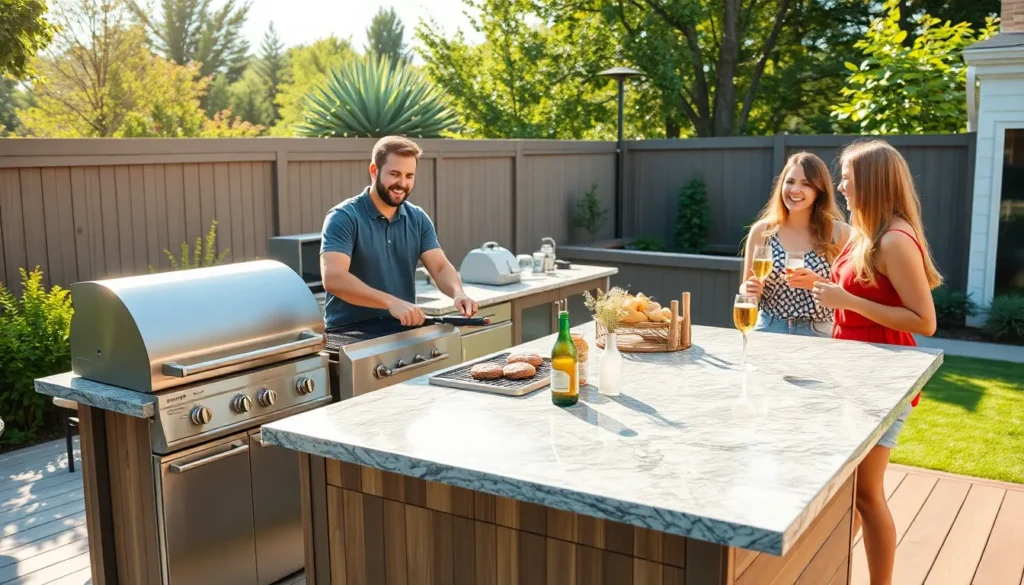We’ve all dreamed of creating that perfect outdoor kitchen setup where friends and family gather for memorable barbecues and summer celebrations. An outdoor BBQ island transforms your backyard into an entertainment paradise that’ll make you the envy of every neighbor on the block.
Building your own BBQ island isn’t just about grilling – it’s about crafting an outdoor lifestyle that brings people together. From sleek modern designs with granite countertops to rustic stone islands with built-in storage we’ll explore ideas that fit every budget and style preference.
Whether you’re working with a compact patio or sprawling backyard space we’ve gathered the most inspiring outdoor BBQ island concepts to help you design your dream setup. Get ready to discover creative layouts essential features and design elements that’ll turn your outdoor space into the ultimate grilling destination.
Modern Minimalist BBQ Island Designs
Modern minimalist BBQ islands embrace clean aesthetics and functional design principles that create sophisticated outdoor cooking spaces. These streamlined designs focus on essential elements while eliminating unnecessary clutter and decorative details.
Sleek Stainless Steel Construction
Stainless steel frames provide the backbone of contemporary BBQ island designs with their weather resistant properties and professional appearance. We recommend 304 grade stainless steel for optimal durability against outdoor elements and frequent use. Marine grade options offer enhanced corrosion resistance for coastal properties where salt air poses additional challenges.
Brushed finishes hide fingerprints and water spots better than polished surfaces while maintaining the sleek industrial aesthetic. Powder coated steel alternatives deliver similar visual impact at lower costs while providing excellent protection against rust and fading. Modular stainless steel components allow for customization and future expansion without compromising the unified design theme.
Integration with built in grills creates seamless cooking stations that professional chefs prefer for their functionality and ease of maintenance. Stainless steel backsplashes protect adjacent surfaces from grease splatter while adding vertical design elements to the overall composition.
Clean Line Granite Countertops
Granite slabs with straight edges define the minimalist aesthetic through their uninterrupted surfaces and natural stone beauty. We suggest selecting granite colors like absolute black, steel gray, or white ice that complement stainless steel appliances and maintain the monochromatic color scheme. Honed finishes provide subtle texture while avoiding the high gloss appearance that can appear too formal for outdoor settings.
Waterfall edge details create dramatic visual impact where countertops extend vertically to the ground on exposed sides. This design technique adds architectural interest while maintaining the clean line principle that defines minimalist styling. Mitered corners eliminate visible seams and create the illusion of solid stone construction.
Integrated drainboards carved into granite surfaces eliminate the need for separate prep accessories while maintaining the streamlined appearance. We recommend positioning these functional elements near the grill area for convenient food preparation and cleanup. Rounded interior corners prevent bacterial buildup and simplify sanitization procedures.
Built-In Storage Answers
Concealed cabinet systems maintain the uncluttered appearance while providing essential storage for grilling tools, propane tanks, and outdoor dining accessories. We design these storage areas with full extension drawer slides that support heavy loads and provide complete access to stored items. Soft close mechanisms prevent slamming while extending the life of cabinet hardware.
Stainless steel cabinet doors create visual continuity with other island components while offering superior weather protection compared to traditional wood options. Magnetic latches eliminate visible hardware while ensuring secure closure during windy conditions. Interior LED lighting systems illuminate storage areas for evening cooking sessions.
Pull out trash receptacles keep waste containers hidden beneath countertops while remaining easily accessible during food preparation and cleanup. We incorporate dual compartment systems that separate recyclables from general waste to support environmentally conscious outdoor entertaining. Weather sealed lids prevent pest intrusion and contain odors between collection days.
Dedicated utensil drawers with custom dividers organize grilling tools and prevent damage from loose storage arrangements. Felt lined compartments protect knife edges while maintaining the quiet operation that enhances the peaceful outdoor cooking experience.
Rustic Stone and Brick BBQ Islands
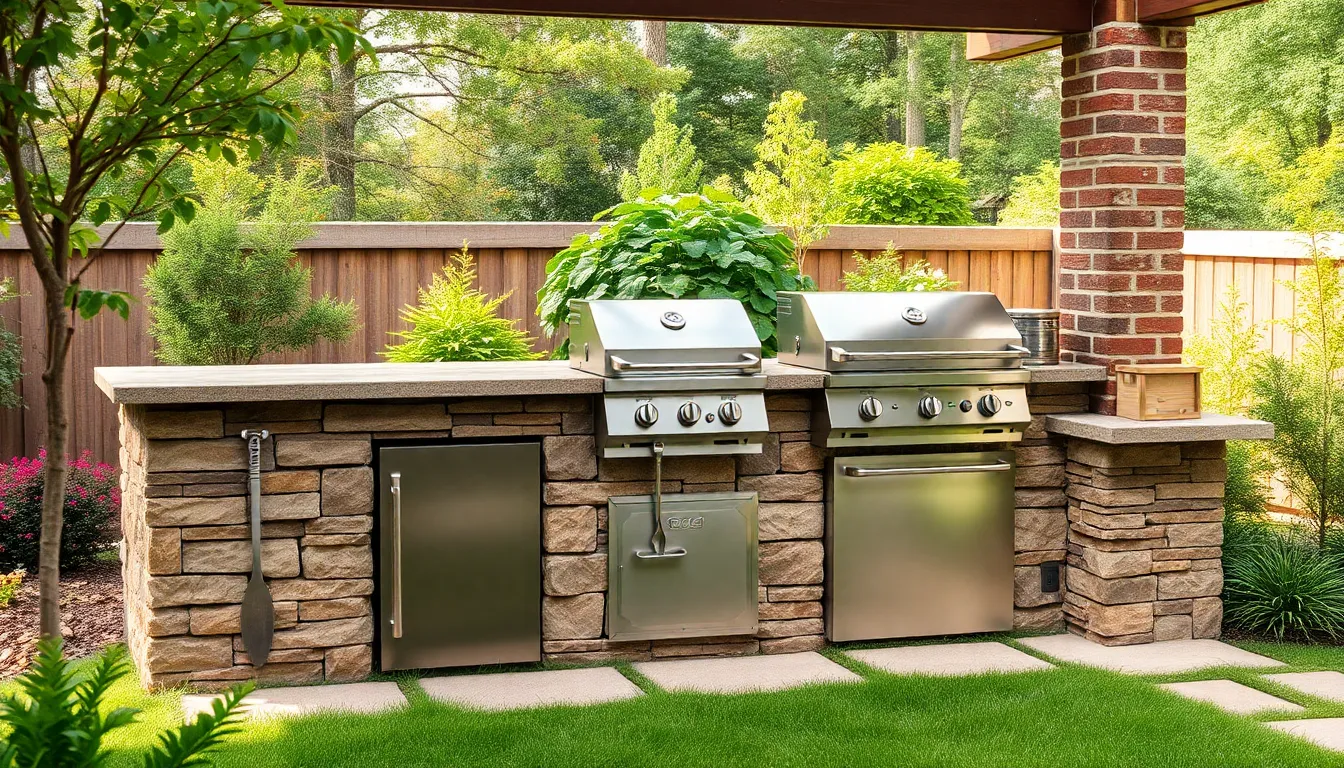
While modern minimalist designs offer sleek sophistication, rustic stone and brick BBQ islands create timeless outdoor spaces that blend naturally with garden landscapes. These materials bring warmth and character that complements traditional backyard settings perfectly.
Natural Stone Veneer Options
Natural stone veneers provide authentic stone appearance with significantly less weight and cost than full stone blocks. These thin slices of natural stone get applied to backing structures, delivering both durability and the rustic aesthetic of natural rock. Slate offers dramatic gray tones with natural texture variations, while granite provides speckled patterns in multiple color options. Limestone creates softer, neutral backdrops that age beautifully over time.
Stone veneer installation requires proper backing support but weighs considerably less than solid stone construction. We recommend using moisture barriers behind veneers to prevent water damage in outdoor applications. Popular veneer thicknesses range from 1 to 3 inches, allowing flexibility in design depth and visual impact.
Weather resistance makes stone veneer ideal for year-round outdoor exposure. These materials withstand freeze-thaw cycles, UV radiation, and moisture without deteriorating like synthetic alternatives. Fire resistance adds another layer of safety for high-heat cooking environments.
Traditional Brick Construction
Traditional brick BBQ islands use solid bricks laid with specialized outdoor mortar to form durable island structures. This construction method creates classic, timeless designs that evoke traditional outdoor cooking spaces. Brick provides excellent heat resistance, making it essential for areas near grills and fire pits.
Color variations in traditional bricks allow customization for different rustic aesthetics. Red clay bricks offer classic warmth, while buff and tan options provide lighter, more neutral tones. Weathered or tumbled finishes create aged appearances that look established from day one.
Mortar selection becomes crucial for outdoor brick construction longevity. We use specialized outdoor mortar mixes that enhance weather resilience and prevent cracking from temperature fluctuations. Proper mortar joints also allow for thermal expansion without structural damage.
Storage integration works naturally with brick construction techniques. Built-in shelves and storage spaces get incorporated during the laying process, creating sturdy compartments for grilling tools and supplies. This approach eliminates the need for separate storage answers.
Fire-Resistant Material Benefits
Fire resistance stands as the primary safety advantage of natural stone and brick materials. These materials don’t burn or emit toxic fumes under extreme heat, providing essential safety for outdoor cooking areas. Unlike wood or synthetic materials, stone and brick maintain structural integrity even during grease fires or flare-ups.
| Material | Fire Rating | Heat Tolerance | Maintenance Level |
|---|---|---|---|
| Natural Stone Veneer | Excellent | 2,000°F+ | Low |
| Traditional Brick | Excellent | 1,800°F+ | Low |
| Synthetic Materials | Poor | 200-400°F | High |
Thermal mass properties help stabilize temperatures around cooking sites. Stone and brick absorb heat during cooking and release it slowly, creating more consistent cooking environments. This thermal regulation reduces hot spots and provides better heat distribution for outdoor kitchens.
Maintenance requirements decrease significantly with fire-resistant materials. Heat damage becomes virtually nonexistent, eliminating repairs from scorching or melting that affect other materials. Weather exposure causes minimal deterioration, meaning these BBQ islands maintain their appearance for decades with basic cleaning.
Cost effectiveness emerges over time even though higher initial investments. While stone and brick materials cost more upfront, their longevity and minimal maintenance requirements provide better value than materials requiring frequent replacement or repair.
Multi-Level BBQ Island Configurations

Elevating your outdoor cooking experience involves creating ever-changing height variations that enhance both functionality and visual appeal. Multi-level designs transform standard flat cooking surfaces into sophisticated outdoor kitchens that accommodate different tasks and social interactions.
Two-Tier Cooking and Prep Areas
Two-tiered island designs separate cooking and preparation zones at strategic heights for optimal workflow efficiency. The upper tier typically hosts grills and cooking appliances at the standard 36-inch height, providing easy access and proper ventilation for heat sources. Meanwhile, the lower tier creates a spacious prep surface that keeps raw food preparation safely away from direct cooking heat.
This separation enhances safety protocols by preventing cross-contamination between prep and cooking areas. Visual segmentation adds architectural interest to your outdoor space, breaking up large expanses of countertop into purposeful zones. The height difference also allows for better organization of cooking tools and ingredients, with each level serving distinct functions in your grilling workflow.
Elevated Bar Seating Integration
Elevated bar seating creates natural divisions between hosts and guests while maintaining social interaction opportunities. The cooking area remains at the standard 36-inch height, while bar seating areas rise to 42-45 inches to provide comfortable standing height for seated guests. This configuration invites conversation without interfering with cooking operations.
Guests can comfortably sit or lean against the elevated bar section, creating a defined entertainment zone within the cooking space. The height difference establishes clear boundaries that keep visitors safely away from hot cooking surfaces while encouraging social engagement. This dual-purpose design transforms your BBQ island into both a functional kitchen and an entertainment hub for backyard gatherings.
Graduated Height Design Elements
Graduated heights across the entire BBQ island create depth and visual drama through layered surfaces. Step-down counters transition from cooking surfaces to prep areas, then rise again to bar or serving counters, establishing a ever-changing industry of functional zones. This approach accommodates different cooking elements and appliances while considering ergonomic needs for various users.
Layered surfaces enhance the island’s usability by providing task-exact work heights for different cooking activities. The graduated design also adds sculptural quality to your outdoor space, creating visual interest from multiple viewing angles. Each height level serves exact purposes, from food preparation and cooking to serving and entertaining, maximizing the versatility of your outdoor kitchen investment.
L-Shaped and Corner BBQ Island Layouts

L-shaped and corner configurations represent strategic design answers for maximizing outdoor kitchen functionality while accommodating various backyard sizes and entertaining needs.
Space-Maximizing Corner Designs
Corner BBQ islands transform underutilized spaces into highly functional cooking centers by positioning grills and work surfaces along two connected sides. We’ve found that this diagonal placement creates ample workspace without overcrowding central patio areas, making it ideal for smaller backyards where every square foot matters.
Modular kits offer an efficient approach to corner island construction, combining prefabricated sections that optimize both space and functionality with reduced installation effort. Cedar, redwood, and tropical woods enhance the longevity of these corner designs while providing natural weather resistance that withstands outdoor elements.
Beneath counter storage becomes particularly valuable in corner configurations, as the dual sided design naturally creates additional cabinet space for grilling accessories and outdoor dinnerware. Natural flow patterns emerge around corner islands, allowing guests to circulate freely while keeping the cooking area compact yet fully functional.
Extended Counter Work Areas
Extended countertops along L-shaped and corner BBQ islands provide generous surface areas that streamline food preparation, plating, and serving processes. Long counter runs make it easier to organize cooking tools and ingredients efficiently, creating dedicated zones for different culinary tasks.
Bar seating along the outer edge of extended counters encourages social interaction between cooks and guests without interfering with food preparation activities. Natural stone and weather resistant wood materials like cedar or redwood offer durability while maintaining aesthetic appeal across various design themes.
Multiple work zones emerge naturally with extended counter configurations, allowing simultaneous food prep and plating activities that keep outdoor entertaining smooth and organized. Counter heights can vary within the same island to accommodate different tasks, from standard prep work to comfortable dining experiences.
Traffic Flow Optimization
Clear, open walkways around L-shaped and corner BBQ islands prevent congestion during gatherings by creating natural circulation patterns that distribute guests between cooking, eating, and lounging areas. Strategic placement eliminates bottlenecks that commonly occur when outdoor kitchens lack proper flow consideration.
Curved island elements complement L-shaped designs by mimicking natural backyard contours and facilitating smooth movement around cooking spaces. These flowing lines seamlessly connect BBQ islands with adjacent fire pits or seating areas, creating cohesive outdoor entertainment zones.
Open ended configurations allow traffic to flow naturally around cooking spaces, ensuring hosts can move efficiently between prep areas and serving stations. Diagonal corner placement creates multiple access points that accommodate both casual gatherings and larger entertaining events without crowding the primary cooking zone.
Portable and Modular BBQ Island Systems
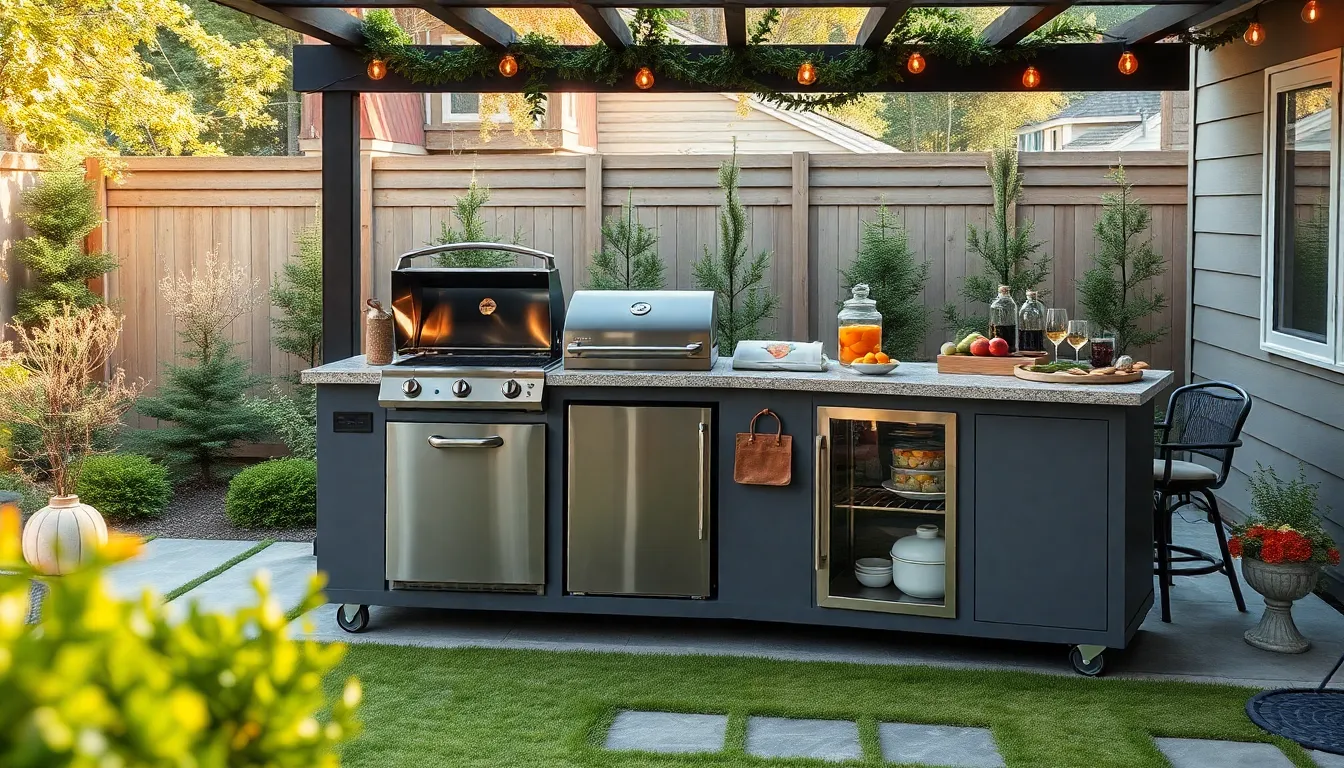
Modular BBQ islands revolutionize outdoor cooking by offering unmatched flexibility and customization for every backyard setup. We’ll explore how these innovative systems adapt to your exact needs while maintaining the functionality of permanent installations.
Wheeled Island Mobility Features
Wheeled BBQ islands transform outdoor cooking spaces with their exceptional mobility capabilities. We recommend looking for units with heavy duty casters that can support the weight of fully loaded islands while rolling smoothly across various outdoor surfaces.
Moving your island becomes effortless when you need to clean underneath, rearrange your patio for different entertaining layouts, or reposition the unit to catch better lighting throughout the day. Mobility features allow you to adapt your outdoor space for multiple functions beyond just grilling.
Repositioning capabilities prove invaluable during seasonal changes when you want to move the island to covered areas for protection from harsh weather conditions. We’ve found that portable and modular units most commonly incorporate wheel systems, while fully built in islands rarely offer this convenience.
Expandable Component Options
Component expansion transforms basic grill stations into comprehensive outdoor kitchens through strategic additions. We can help you plan an evolution from simple 6 foot islands to impressive 10 foot cooking centers that accommodate multiple appliances and features.
Building your island gradually allows you to add side burners, power burners, refrigerators, drop in coolers, sinks, storage drawers, and bar seating as your budget and needs expand. Each new component integration requires careful planning for electrical wiring and plumbing connections.
Maintaining adequate countertop space becomes crucial as you expand your island length and add more appliances for food preparation and serving areas. We recommend balancing appliance additions with functional workspace to ensure your expanded island remains practical for daily use.
Seasonal Storage Capabilities
Storage answers within modular islands keep grilling tools, utensils, and seasonal accessories organized when not actively in use. We design compartments that protect equipment from weather exposure while maintaining easy access during cooking sessions.
Disassembling modular systems for winter storage extends the lifespan of your investment by protecting appliances from harsh seasonal conditions. Units with removable components can be relocated to covered areas like garages or storage sheds during off seasons.
Protecting your outdoor cooking investment requires planning for seasonal elements that can damage exposed appliances and surfaces over time. We’ve observed that islands with thoughtful storage design and portability features maintain their condition and functionality much longer than permanently exposed installations.
Luxury Resort-Style BBQ Islands

Resort-style BBQ islands elevate outdoor cooking to an entirely new level, transforming your backyard into a sophisticated culinary destination. We’ll explore how these premium outdoor kitchens combine luxury materials with advanced functionality to create the ultimate entertaining experience.
Premium Appliance Integration
Top-tier appliances transform your outdoor kitchen into a professional-grade cooking station. We recommend incorporating built-in gas grills alongside charcoal options for maximum cooking versatility. Dual grill setups allow you to prepare different dishes simultaneously while maintaining distinct flavors.
Pizza ovens add restaurant-quality capabilities to your outdoor space. These wood-fired or gas-powered units reach temperatures exceeding 800°F, creating authentic artisanal pizzas in minutes. Power burners complement your main grilling area with high-heat cooking for woks, stockpots, and searing applications.
Refrigerated storage keeps ingredients fresh and beverages cold throughout your gathering. Built-in refrigerators eliminate trips to the indoor kitchen, while ice makers ensure you’ll never run short during parties. Seamless integration of these appliances creates a cohesive appearance that rivals indoor kitchen designs.
Weather-resistant finishes protect your investment while maintaining aesthetic appeal. Stainless steel appliances feature marine-grade construction that withstands coastal environments and extreme temperatures. Powder-coated aluminum frameworks provide lightweight durability without sacrificing structural integrity.
Outdoor Kitchen Amenities
Custom countertops create functional work surfaces that withstand outdoor conditions. Granite surfaces offer heat resistance and stain protection, while concrete options provide modern aesthetics with customizable finishes. Both materials handle temperature extremes without cracking or fading.
Modular storage systems maximize organization while maintaining clean lines. Dedicated drawers for utensils, spices, and grilling accessories keep essentials within reach. Dry storage compartments protect paper goods and non-perishables from moisture and pests.
Integrated sinks eliminate the need for indoor cleanup between courses. Deep basin designs accommodate large pots and serving platters, while high-arc faucets provide clearance for filling tall containers. Prep areas adjacent to sinks streamline food preparation workflows.
Strategic lighting extends cooking hours into the evening. LED strip lights illuminate work surfaces without creating harsh shadows, while pendant fixtures provide ambient lighting for dining areas. Weather-resistant electrical outlets power small appliances and charging stations for devices.
Durable construction materials ensure decades of reliable performance. Concrete block foundations resist settling and cracking, while aluminum door frames won’t rust or corrode. These materials maintain structural integrity through freeze-thaw cycles and extreme weather events.
Entertainment Zone Features
Fire pits create natural gathering spaces that extend the usable season. Integrated designs complement your island’s materials and finishes while providing warmth for cool evenings. Gas fire features offer instant ignition and adjustable flame control for safety and convenience.
Coordinated seating areas encourage social interaction during cooking. Bar-height stools positioned around the island perimeter allow guests to watch food preparation while maintaining conversation. Weather-resistant cushions and covers protect furniture investments year-round.
Multiple station layouts accommodate large gatherings with distinct activity zones. Separate prep areas prevent congestion while allowing multiple cooks to work simultaneously. Beverage stations with built-in coolers keep drinks accessible without interrupting cooking workflows.
Audio-visual integration transforms your outdoor space into an entertainment hub. Weather-resistant speakers provide background music or game audio, while outdoor televisions create viewing areas for sports events. Smart home integration allows control of lighting, music, and temperature from mobile devices.
Thoughtful spatial planning creates seamless transitions between cooking and lounging areas. Open-ended island configurations prevent bottlenecks during busy gatherings, while curved elements soften hard edges and improve traffic flow. Strategic placement of amenities encourages natural movement patterns that enhance the overall entertaining experience.
Budget-Friendly DIY BBQ Island Projects

Building your own BBQ island doesn’t require very costly or hiring expensive contractors. We’ve discovered that strategic material choices and smart construction methods can create stunning outdoor cooking spaces for a fraction of traditional costs.
Concrete Block Construction
Concrete cinder blocks form the foundation of our most recommended budget-friendly approach, offering exceptional durability at approximately $2-4 per block. We position these blocks as structural walls and bases, creating solid frameworks that easily support countertops and heavy grills without compromising stability.
The versatility of concrete block construction allows us to customize storage spaces and shelving directly within the walls during assembly. We recommend using standard 8x8x16 inch blocks for main structures, with smaller 4x8x16 inch blocks for detailed work and partitions.
Weather resistance stands out as a key advantage, with concrete blocks maintaining structural integrity through freeze-thaw cycles and extreme temperatures. We finish these blocks with stucco, tile, or stone veneer to transform utilitarian construction into attractive facades that complement any backyard aesthetic.
Flexibility in design shapes makes concrete blocks ideal for rectangular, L-shaped, or curved island configurations that adapt to your exact outdoor space requirements. We’ve found that curved designs require cutting blocks at angles, which adds minimal cost but significantly enhances visual appeal.
Reclaimed Material Options
Salvaged wood materials offer tremendous cost savings while adding unique character that new materials can’t replicate. We source old pallets, reclaimed cedar, and weathered redwood from demolition sites, barns, and online marketplaces at 30-50% below retail lumber prices.
Tropical hardwoods like teak and mahogany become affordable when purchased as reclaimed materials, providing natural durability and exotic grain patterns for countertops and framework construction. We recommend inspecting reclaimed wood for structural integrity and treating it with appropriate sealers before installation.
Stone and brick salvage creates visually stunning island facades while reducing material costs by up to 60% compared to new masonry products. We locate these materials through architectural salvage yards, demolished building sites, and Craigslist marketplace listings in our local areas.
Sustainability benefits accompany the cost savings, as reclaimed materials reduce waste streams and minimize environmental impact from new resource extraction. We’ve discovered that mixing reclaimed elements with new materials creates distinctive designs that showcase both budget consciousness and environmental responsibility.
Cost-Effective Design Alternatives
Simple geometric shapes minimize material waste and construction complexity, with rectangular and L-shaped islands requiring fewer cuts and specialized components than curved or multi-level designs. We recommend starting with basic rectangular forms measuring 6-8 feet in length for optimal material efficiency.
Two-tier island configurations maximize functionality while using standard lumber dimensions, creating distinct zones for food preparation and casual dining without custom millwork expenses. We position the lower tier at 36 inches for comfortable prep work and the upper tier at 42 inches for bar-style seating.
| Design Element | Standard Cost | Budget Alternative | Savings |
|---|---|---|---|
| Natural Stone Countertop | $50-80/sq ft | Concrete Slab | 70-80% |
| Custom Cabinetry | $200-400/linear ft | Open Shelving | 60-75% |
| Built-in Appliances | $2,000-5,000 | Portable Units | 40-60% |
Material mixing strategies balance aesthetics with affordability by combining inexpensive concrete blocks with modest wood or stone accents in key visual areas. We focus accent materials on countertop edges, cabinet doors, and decorative panels where they create maximum impact.
Essential-first approach prioritizes grill space, basic countertops, and fundamental storage before adding luxury features like pizza ovens or multiple burners. We recommend establishing core functionality first, then expanding with additional features as budget allows over subsequent seasons.
Small Space BBQ Island Solutions
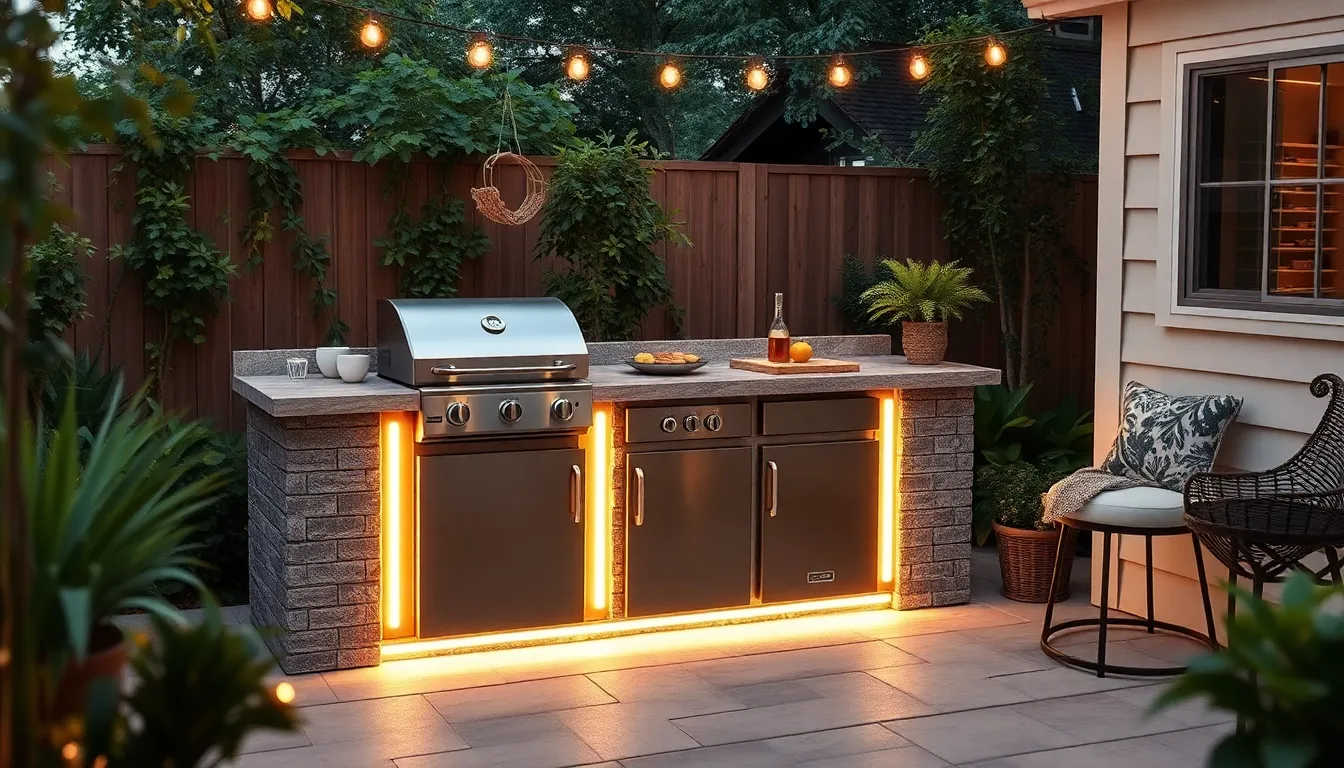
Limited outdoor space doesn’t mean sacrificing your BBQ island dreams. Creative design approaches can transform even the smallest patios into functional outdoor cooking destinations.
Compact Design Strategies
Focusing on essential functions rather than every possible feature keeps your island space efficient and budget friendly. We recommend concentrating on 2-3 key uses like grilling, prep counter, and storage instead of trying to include a full chef’s range or bar setup. This streamlined approach maintains versatility while conserving precious square footage.
Doubling up on functions maximizes your island’s potential without expanding its footprint. Counter space can serve as both prep area and dining surface, while combining appliances like a slow cooker and grill conserves room for movement and entertaining. Modular units from retailers like IKEA and BetterPatio offer streamlined designs specifically created for small and medium outdoor spaces.
Separating functions into multiple smaller islands often works better than cramming everything into one large unit. Position your grill island near the house for convenience and place a bar island further in the backyard to create distinct zones while maintaining full functionality. L-shaped designs that incorporate bar seating extend usable space by combining cooking and dining areas without requiring additional furniture.
Vertical Storage Maximization
Building upward rather than outward transforms wasted air space into valuable storage real estate. Vertical cabinets or shelving integrated into your island structure free up floor space for movement and seating while keeping essentials within easy reach. Custom built answers can extend from counter height to overhead storage without overwhelming your compact design.
Adding hooks or racks for utensils and grilling tools on vertical surfaces keeps items accessible but off your counters. Wall mounted magnetic strips hold knives securely, while hanging baskets store smaller accessories like spice containers and cleaning supplies. These vertical storage elements maintain your island’s clean lines while maximizing organization.
Mounting LED strip lights or post lights vertically around your island provides illumination without cluttering work surfaces. These lighting answers create ambiance for evening entertaining while ensuring safe food preparation after dark. Solar powered options eliminate the need for electrical connections in remote outdoor locations.
Multi-Purpose Functionality
Integrating bar seating along your island counter creates natural dining space that doubles as prep area when needed. This multi functional element eliminates the need for separate outdoor dining furniture while encouraging social interaction during cooking. Counter height stools tuck neatly under overhangs to save space when not in use.
Incorporating sinks or small refrigerators transforms your compact island into a complete outdoor kitchen station. Mini fridges keep beverages cold and ingredients fresh, while prep sinks eliminate trips back to the house for cleaning and washing. These convenience features make your small space island surprisingly self sufficient.
Outdoor lighting options like string lights, LED strips, and solar powered post lights extend your island’s usability into evening hours. Strategic placement creates zones for cooking, dining, and socializing while adding visual interest to your compact design. Battery powered options offer flexibility for seasonal arrangements and special occasions.
Weather-Resistant BBQ Island Materials
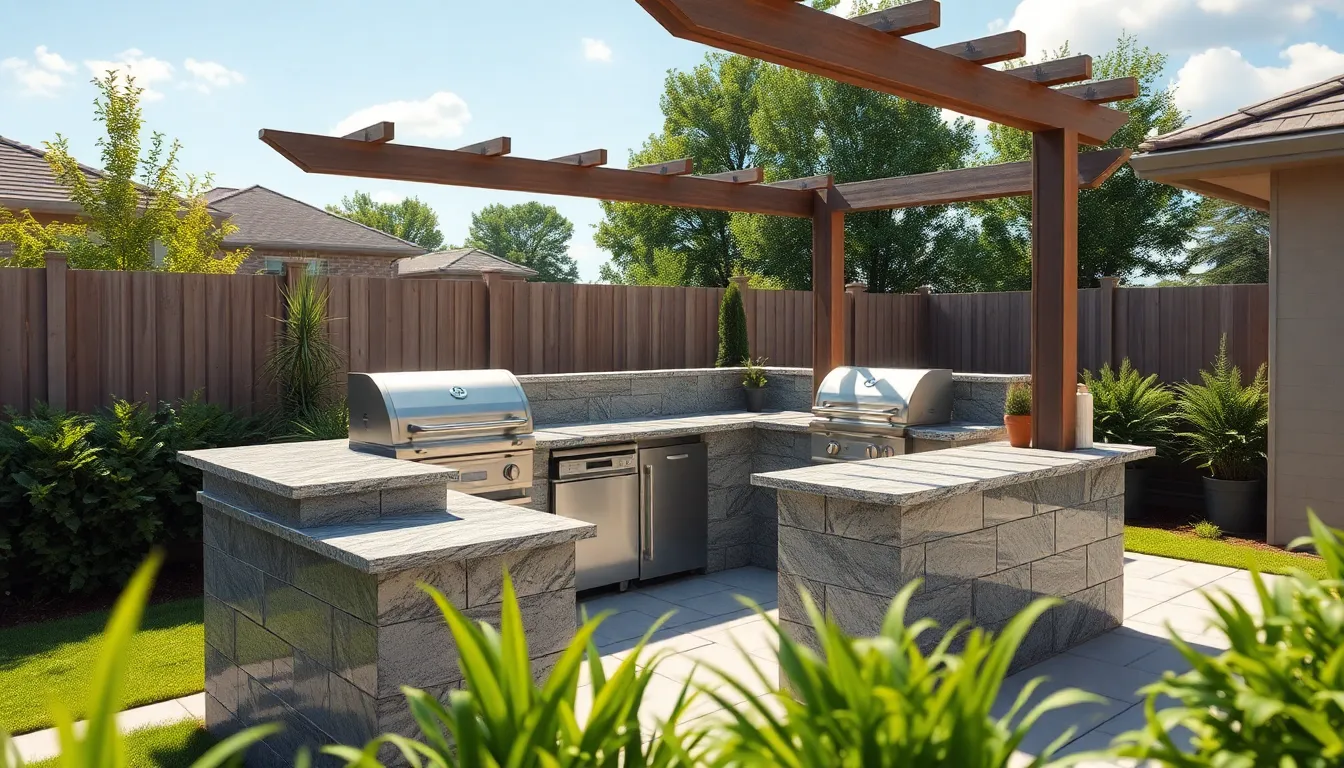
Building a lasting outdoor BBQ island requires materials that can handle everything Mother Nature throws at them. We’ll explore the most reliable options that combine durability with style.
Durable Countertop Selections
Stone materials like granite and concrete stand out as our top choices for BBQ island countertops due to their exceptional heat resistance and outdoor durability. Granite countertops resist stains and scratches while maintaining their appearance over years of use, making them ideal for high-traffic cooking areas. We recommend proper sealing to enhance longevity and protect against weather elements that could compromise the surface.
Concrete countertops offer incredible customization potential with various textures and colors that can mimic other premium materials. These surfaces withstand high heat and outdoor exposure without damage, giving us flexibility in design while ensuring long-term performance. Custom concrete work allows us to create unique features like integrated cutting boards and built-in trivets.
Both materials require minimal maintenance when properly installed and sealed. Granite typically needs resealing every 1-2 years, while concrete may require annual sealing depending on local climate conditions.
All-Weather Cabinet Options
Stainless steel cabinets lead our recommendations for outdoor storage due to their superior rust resistance and structural durability. These cabinets handle moisture, temperature fluctuations, and UV exposure without compromising functionality or appearance. We find that 304-grade stainless steel provides the best balance of corrosion resistance and cost effectiveness.
Weather-resistant composite materials offer an alternative that combines durability with design flexibility. These engineered materials resist warping, swelling, and rot while providing various finish options to match your outdoor aesthetic. Treated wood cabinets can withstand elements when properly maintained, though they require more regular care than steel or composite options.
Ventilated cabinet systems prevent overheating and moisture accumulation, which extends both appliance life and structural integrity. We recommend integrated ventilation in concrete panel systems to ensure optimal airflow around stored equipment and supplies.
Protective Cover Systems
Fitted vinyl covers provide the most cost-effective protection for BBQ islands, shielding surfaces from rain, UV rays, and debris. These custom-fit covers preserve finishes and prevent weather damage while remaining easy to remove for cooking sessions. Heavy-duty vinyl withstands wind and maintains its protective qualities for 3-5 years with proper care.
Retractable awnings and pergolas offer permanent shade answers that protect both the island and users from harsh sun exposure. These structures can reduce UV damage by up to 95% while creating comfortable cooking environments during peak daylight hours. Motorized retractable systems provide convenience and can extend to cover dining areas as well.
Permanent roofing structures deliver the ultimate protection for high-end BBQ islands, creating true outdoor kitchens that function year-round. These installations require professional design and construction but provide complete weather protection while adding important property value. We suggest incorporating proper drainage and ventilation to prevent moisture buildup under covered areas.
Smart Technology BBQ Island Features

Modern outdoor cooking has evolved beyond traditional grilling, with smart technology transforming BBQ islands into sophisticated culinary command centers. These innovative features enhance convenience, safety, and overall outdoor entertaining experiences.
Automated Temperature Controls
Smart grills equipped with automated temperature controls revolutionize outdoor cooking by maintaining precise heat levels through advanced algorithms and smartphone connectivity. Nexgrill’s Neevo™ Smart Grills feature the NEX-fi™ enabled SureTemp controller and LED control panel, allowing users to monitor and adjust temperatures remotely via Bluetooth or Wi-Fi connections. These systems eliminate guesswork from grilling by automatically adjusting heat output to maintain consistent cooking temperatures.
Remote monitoring capabilities let us step away from the grill without compromising food quality. The technology reduces the need for constant attention, freeing hosts to interact with guests while ensuring perfectly cooked meals. Digital panels display real-time temperature readings and cooking progress, making it easier to achieve professional-level results consistently.
Built-In Lighting Systems
Weather-responsive LED lighting systems enhance both functionality and ambiance in smart BBQ islands. These systems provide bright task lighting for detailed food preparation and cooking, then transition to soft ambient lighting for post-dinner socializing. Remote app control and voice command compatibility allow instant adjustments to brightness, color, and timing based on exact needs or occasions.
Motion sensor integration automatically activates lighting when someone approaches the cooking area, improving safety and security while conserving energy. Smart lighting connects seamlessly with broader home automation systems, enabling customizable scenes that adapt to different entertaining scenarios. Users can program lighting schedules that complement outdoor gatherings, from sunset dinner parties to late-night casual conversations.
Wireless Connectivity Options
Wi-Fi and Bluetooth connectivity transform outdoor BBQ islands into integrated smart kitchen ecosystems. Dedicated mobile apps provide centralized control over all connected appliances, including grills, lighting systems, and entertainment features. This wireless integration allows complete management of the outdoor cooking environment from anywhere on the property.
Remote operation capabilities enable hosts to monitor cooking progress while mingling with guests away from the grill area. Smart connectivity extends beyond cooking appliances to include music systems, ambient lighting controls, and even weather monitoring features. The seamless integration reduces the physical demands of outdoor entertaining, letting us focus on creating memorable experiences rather than managing multiple devices manually.
Conclusion
Your dream BBQ island is within reach regardless of your budget space or style preferences. We’ve shown you how to create everything from sleek modern designs to charming rustic retreats that’ll become the heart of your outdoor entertaining.
Whether you’re building a simple DIY project or investing in a high-tech culinary command center the key is choosing features that match your lifestyle and cooking habits. Smart planning weather-resistant materials and thoughtful design will ensure your investment pays off for years to come.
Start with your must-have features then expand from there. Remember that the best BBQ island is one that brings people together and creates lasting memories in your backyard.
Frequently Asked Questions
What materials are best for building a durable BBQ island?
For maximum durability, use 304 grade stainless steel with brushed finishes for appliances and backsplashes. Natural stone veneers, granite countertops, and traditional brick offer excellent weather resistance and fire protection. These materials maintain structural integrity under extreme heat and require minimal maintenance, making them cost-effective long-term investments despite higher upfront costs.
How much space do I need for a BBQ island in my backyard?
BBQ islands can fit various backyard sizes. Corner and L-shaped designs maximize functionality in smaller spaces, while multi-level configurations work well in larger areas. Focus on essential functions and vertical storage for compact designs. Ensure adequate traffic flow around the island with at least 3-4 feet of clearance for safe movement.
Can I build a BBQ island on a budget?
Yes, DIY BBQ islands can be very cost-effective. Use concrete block construction for durability and customization. Incorporate reclaimed materials like salvaged wood and stone for character and savings. Choose simple geometric shapes to minimize material waste, and prioritize essential features before adding luxury elements to control costs.
What’s the difference between portable and permanent BBQ islands?
Portable islands offer flexibility with wheeled mobility and modular components that can be expanded or reconfigured. They’re ideal for renters or those wanting seasonal storage options. Permanent islands provide more stability, larger cooking surfaces, and can include utilities like gas lines and electrical connections for a full outdoor kitchen experience.
How do I maintain my BBQ island year-round?
Use weather-resistant materials like stainless steel and stone for longevity. Install protective covers or permanent roofing structures to shield from harsh weather. Clean surfaces regularly and inspect for wear. For modular systems, consider disassembling components for winter storage to extend their lifespan and maintain functionality.
What smart technology can I add to my BBQ island?
Modern BBQ islands can include automated temperature controls with smartphone connectivity, built-in LED lighting systems with motion sensors, and wireless connectivity for centralized appliance control. These features allow remote monitoring of cooking progress, enhanced safety through proper illumination, and seamless management of your outdoor cooking environment.
Should I choose a single-level or multi-level BBQ island design?
Multi-level designs offer superior functionality by separating cooking and preparation zones, improving workflow efficiency and food safety. Two-tier configurations create natural divisions between hosts and guests while maintaining social interaction. Single-level designs work well for smaller spaces and simpler cooking needs, offering easier access and maintenance.
What countertop materials work best for outdoor BBQ islands?
Granite and concrete are top choices for their heat resistance and durability. Clean-line granite complements stainless steel appliances, while waterfall edges and integrated drainboards create streamlined appearances. Both materials withstand weather extremes and maintain their appearance with minimal maintenance, making them ideal for outdoor cooking environments.

